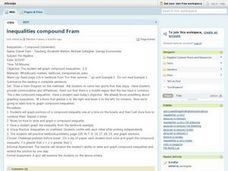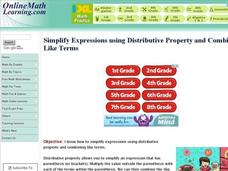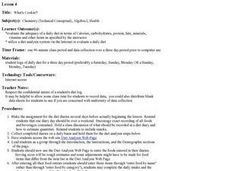Curated OER
Function or Not a Function
Graphing linear equations on the TI is easy! Through examination of graphs and identification if it is a function or not, this lesson can relate to the real world.
Curated OER
Discriminant Testing
The class works to identify solutions using the discriminant.They use part of the quadratic formula to find the number of solutions a quadratic equation will have. They calculate how-many times the quadratic function will cut the x-axis....
Curated OER
Solving Systems using Elimination
Using elimination to find the point of intersection of two lines, students learn to solve systems of equation. They graph their solutions and use the TI to verify the solution.
Curated OER
Exponential vs. Power
Pupils differentiate between exponential and power functions. They identify the base, exponent and properties of exponential functions. They also graph the functions using the TI calculator.
Curated OER
Exponents Worksheet: 2 of 2
Not the most attractive worksheet, but useful nonetheless. A chart is displayed for mathematicians to fill in the power, base number, exponent, the repeated multiplication problem, and the total value. They complete this activity for...
Curated OER
Geo-Wrap Vests
First graders use geometric shapes to create and extend patterns. Students read a book and view African garments. They identify patterns in the garments. Students create and decorate a paper vest with geometric patterns.
Curated OER
Inequalities Compound Fram
Students practice graphing compound inequalities. They draw a Venn Diagram on two different sports visualizing that their is a middle section on commonality among the two sports groups and then relate that concept to compound inequalities.
Curated OER
Veggie Chop and Data Analysis
First graders chop vegetables into fractions. In this fractions lesson, 1st graders cut vegetables, collect data about favorite vegetables and create a bar graph using the information. Students make inferences about the data and record...
Curated OER
Let's Trade
Second graders engage in a instructional activity which focuses on adding two-digit numbers and the regrouping process. They identify when the regrouping process is necessary and make appropriate "trades" to complete an addition problem.
Curated OER
Wildlife Management
Students examine the effects of various management strategies on the size of wildlife populations. Each student simulates the management of an animal population in a card game, graphs the results of the wildlife game, and participate in...
Curated OER
Angles in Standard Positions
Students identify positive and negative angles using the Unit Circle. In this pre-calculus lesson, students identify the different angles on a unit circle using the coordinate plane and the four different quadrants as a guide. They...
Curated OER
Simplify expressions and Combine Like Terms
Students will use the distributive property to simply expressions by removing parentheses from the expression. Like terms will then be combined to completely simplify the expression.
Curated OER
Active Citizenship: The Civil Rights Work of Bob Moses
Students discuss and describe the impact of Bob Moses as an activist, compare and contrast the work of Bob Moses in the 1960's and today and develop an action plan regarding an issue they feel strongly about.
Curated OER
Jambalaya's Restaurant
Learners use a menu and recipes to work on adding, subtracting, and percentages. They are given they weekly circulators, advertisements, or actual products and students practice figuring out sales tax. Learners figure slaes tax and tip...
Curated OER
What Can We Measure About Chemicals?
In this measuring chemicals worksheet, students investigate measurements of an aluminum slab including the length, width, height, mass, volume and density. They do the same for a piece of aluminum foil and they compare their results....
Curated OER
What's Cookin'?
Students examine their eating habits. In this nutrition lesson, students will journal their eating habits over a period of three days. They will use a diet analysis web page to determine the nutritional factors of their eating habits.
Curated OER
Inequalities and Triangles
Learners prove and apply theorems of triangle inequality and hinge theorem. For this geometry lesson, students will discuss which triangle is bigger and why. They will use theorems, such as Exterior Angle Inequality or the Pythagorean...
Curated OER
Factoring Trinomials
In this online math activity, students factor a series of trinomials given specific equations. This excellent resource allows the students to check their answers and to get "hints" should they run into difficulties.
Curated OER
Equations Lesson Plan
Seventh graders play "What's my Rule" beginning with simple equations and working towards harder problems as student's gain confidence. They evaluate the equations by graphing them. Students identify the slope and y intercepts of the...
Curated OER
Surface Area of a Leaf (Grades 7-9)
In this math and science activity, students read about the process of photosynthesis and plant growth. They determine how a plant's ability to create food is dependent on the surface area of its leaves using geometric calculations. They...
Curated OER
Perimeter and Coin Problems
In this writing algebraic equations worksheet, students write the equation and solve the given word problems. There are 14 perimeter and 12 coin problems. Answers are on the bottom of the pages.
Curated OER
Logarithms For Analog Circuits
In this electric circuit instructional activity, students answer a series of 16 questions about logarithms and how they are used in understanding analog circuits. This instructional activity is printable and the answers are viewed on-line.
Curated OER
Maxima and Minima Problems
Students calculate the maxima and minima of quadratic equations. In this calculus activity, students apply the derivatives by finding the maxima and minima using real life application. They solve optimization using the derivative.
Curated OER
Slope Fields
High schoolers create and analyze slope fields. In this calculus activity, students create a visual of differential equations. They use the Ti Navigator to create slope fields.

























